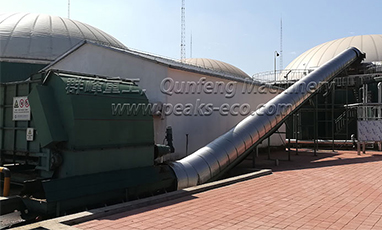 When people think of a waste treatment system, they may associate it with waste dumped into landfills or incinerated. Although such activities are an important part of the process, multiple factors are involved in creating the best integrated solid waste management (ISWM) system. For example, treatment technology can reduce the volume and toxicity of solid waste. These steps can transform it into a more convenient form of disposal. Choose and use waste treatment and disposal methods according to the form, composition and quantity of waste.
When people think of a waste treatment system, they may associate it with waste dumped into landfills or incinerated. Although such activities are an important part of the process, multiple factors are involved in creating the best integrated solid waste management (ISWM) system. For example, treatment technology can reduce the volume and toxicity of solid waste. These steps can transform it into a more convenient form of disposal. Choose and use waste treatment and disposal methods according to the form, composition and quantity of waste.
The following are the main waste treatment and disposal methods:
Thermal waste treatment refers to the process of using heat to treat waste. The following are some of the most commonly used thermal waste treatment technologies:
Incineration is one of the most common waste treatment methods. The method involves burning waste in the presence of oxygen. This heat treatment method is usually used as a means of recovering electric energy or heating. This method has several advantages. It can quickly reduce the amount of waste, reduce transportation costs and reduce harmful greenhouse gas emissions.
Gasification and pyrolysis are two similar methods, both of which decompose organic waste by exposing the waste to a small amount of oxygen and a very high temperature. The pyrolysis process does not use oxygen at all, and there is very little oxygen in the gasification process. Gasification is more advantageous because it allows the combustion process to recover energy without causing air pollution.
Open combustion is a traditional thermal waste treatment method that is harmful to the environment. The incinerator used in this process has no pollution control device. They emit hexachlorobenzene, dioxins, carbon monoxide, particulate matter, volatile organic compounds, polycyclic aromatic compounds, and ash. Unfortunately, this method is still adopted by many local authorities internationally because it provides an inexpensive solution to solid waste.
Sanitary landfills provide the most commonly used waste disposal solutions. These landfills hope to eliminate or reduce the risk of environmental or public health hazards caused by waste disposal. These locations are located where the land element acts as a natural buffer zone between the environment and the landfill. For example, landfills can be made of clay, which is very resistant to hazardous waste, or is characterized by no surface water bodies or low groundwater levels, thereby preventing the risk of water pollution. The use of sanitary landfills has the least harm to health and the environment, but the cost of establishing such landfills is relatively higher than other waste disposal methods.
Controlled landfills are more or less the same as sanitary landfills. These landfills meet many requirements as sanitary landfills, but may lack one or two. Such a dump may have a carefully planned capacity, but no unit plan. There may be no or no partial gas management, basic record keeping or regular cover.
The bioreactor landfill is the result of the latest technological research. These landfills use excellent microbiological processes to accelerate waste decomposition. The control function is to continuously add liquid to maintain the optimal moisture for microbial digestion. Liquid is added by recycling landfill leachate. When the amount of leachate is insufficient, liquid waste such as sewage sludge is used.
Composting project is another most commonly used waste treatment method, which controls the aerobic decomposition of organic waste through the action of small invertebrates and microorganisms. The most common composting techniques include static composting, pest composting, composting composting and in-ship composting.
Anaerobic digestion plants also use biological processes to decompose organic matter. However, anaerobic digestion uses an anaerobic and bacteria-free environment to decompose waste, and compost must have air to allow microorganisms to grow.